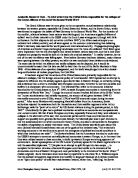Shortly after Stalin’s death a system of collective leadership was announced in Moscow:
Malenkov – regarded as the heir apparent. Only fifty-one, he immediately took Stalin’s place, becoming head of the Council of Ministers and general secretary of the communist party. He assumed the two most important political positions in the country, the top government post and the top party post. The problem was that potential rivals still remained ensconced in the inner councils of both state and party, and they had a vested interest in undermining Malenkov’s power. Otherwise they might be excluded from a real share in governing, just as in Stalin’s time. Within nine days of Malenkov’s assumption of office, they ganged up and forced him to surrender his position as party secretary. Malenkov advocated an economic policy which laid greater emphasis on consumer durables.
Lavrenti Beria – As head of the secret police he was in charge of the terror apparatus which Stalin had deployed with such effect, but this also meant that every other member of the collective leadership, including Malenkov, wanted to eliminate him from power. In June 1953, Beria was arrested on charges of subverting communist rule in East Germany and acting as a foreign agent for the West. In Dec, he was found guilty.
Nikita Khrushchev – Malenkov’s successor as party secretary – Sept 1953. Khruschchev’s great talent was as an organiser, and he exploited his new position for all it was worth. He used the first secretary’s considerable patronage powers to appoint his supporters to key offices throughout the communist hierarchy, and in a very short time managed to create his own political machine inside the party. He succeeded where Malenkov had failed, and controlled both the top state and the top party jobs. Khrushchev defended heavy industry.
Soviet Politics 1917-1991 – Mary McAuley
The ten-year period that followed Stalin’s death was important in two respects.
- It witnessed the reassertion of political power over the means of coercion
- It put back on the table the question of how a system of one-party rule could or should be maintained.
Terror and war had both upset the system. The party became the dominant institution over the secret police, army, and the ministries and it established its control over the economy and all cultural and social institutions.
In 1956 Khrushchev, in his secret sppech, placed a much larger question mark over Stalin’s policies, and spoke of countries finding their own way to socialism. In 1957 a tussle took place over economic policy in which Krushchev seized the initiative by proposing the decentralisation of the industrial ministries, in June his older colleagues reponsded by demanding his resignation. He claimed, however, that only the Central Committee, the body formally responsible for electing the First Secretary, could dismiss him and succeeded in calling a meeting at which he obtained a majority. Until his ouster in 1964, Khrushchev created a Politburo which functioned as his cabinet, and of which he was an undisputed leader. In 1958 he assumed the Chairmanship of the Council of Ministers to complement his party office.
In the Secret Speech Khrushchev called for a return to Leninism. By this he meant rule by a vanguard party, an elite group making policy and controlling government institutions, ministries, and police through the party apparatus. Khrushchev attacked the central state bureacracy, cut down the number of industrial ministries, and put the regional party secretaies in charge of industry. He also engaged in a policy of rapid personnel turnover within the apparatus, bringing in new specialists, and cutting out what he considered to be dead wood.







